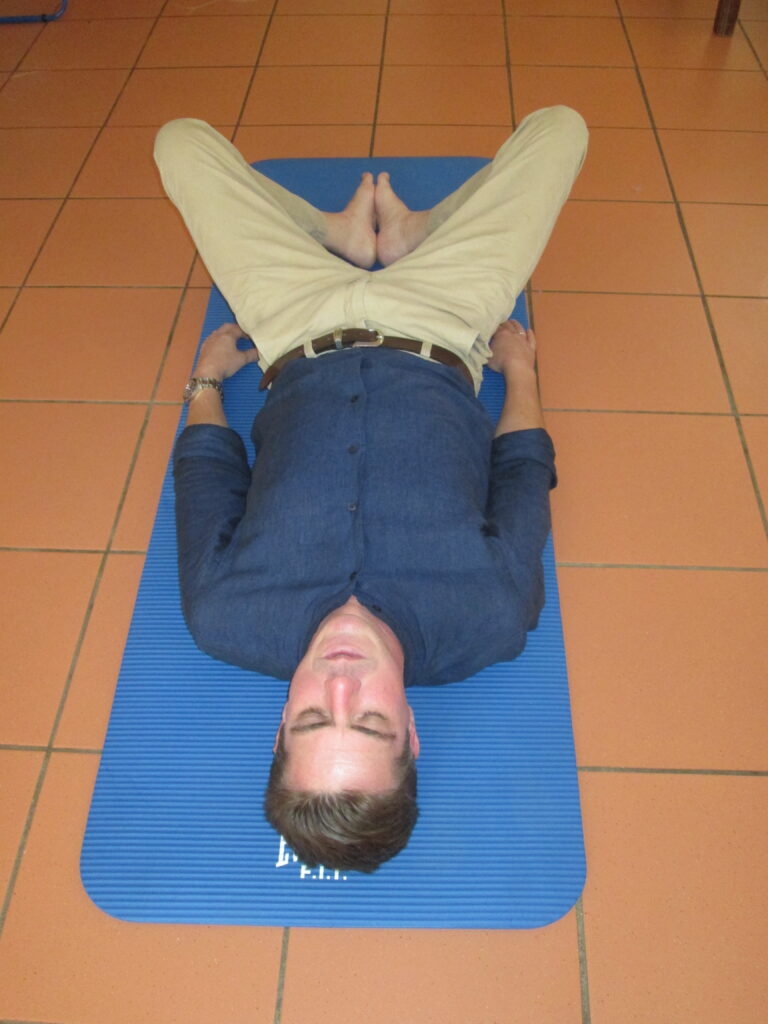What is TRE?
TRE stands for Trauma Releasing Exercises (also known as Trauma and Tension Releasing Exercises). This is the registered brand name for the method developed by Dr David Berceli. The goal of TRE is to help people release trauma and stress from their bodies.
I have been a certified TRE provider since August 2018.
How does TRE work?
The TRE exercises are designed to gently stimulate and activate the muscles that are involved in the fight-flight response. Most of these muscles are in the legs and abdominal area. There are seven exercises, some of which can be done against a wall for support. The last exercise is done lying on the floor.

In this position, the person enters a restful state. After the mild stress of the previous exercises, the muscles may start to relax with slight trembling or shaking. This movement is a totally natural response. It is what happens – or should happen – after any major shock or stress.
Modern humans have learned to suppress or ignore the tremor response. We may even feel ashamed of it, as if shaking when afraid means we are weak. Over the years, we may have learnt either to hide the tremors or not to have them at all. This is partly why trauma becomes locked into our system.
TRE is as simple as restoring the tremor response and learning to work with it to enhance our body’s innate healing ability and balance.
Is TRE suitable for everyone?
TRE is not the only way of releasing stress and trauma. It is safe and effective for many people, but some people benefit more from other approaches.
Any activity that gets us into a parasympathetic state, rather than the fight, flight, freeze, or fawn state, can help us recover from trauma. Parasympathetically oriented activities include
- progressive muscle relaxation exercises
- massage
- doing creative hobbies (arts and crafts)
- journals and creative writing
- drumming
- music
- dance or movement therapy
- walking in nature
Is TRE good for chronic pain?
Some people find TRE effective for reducing chronic pain. This kind of pain is linked to patterns of deeply stored tension in the body. Once the tension starts to release, the pain level drops.
Other forms of pain are not all that amenable to TRE. Some pain is related to the immune system or even to the pain system itself. Examples are chronic inflammation (e.g. arthritis), auto-immune conditions, low endorphin levels, mast cell disorder, allergies, some nerve pain, and weak connective tissue. This pain is not muscular or skeletal. It might not help all that much to release the fascia, which is what happens if you do TRE for a while.
If you live with chronic pain and fatigue that seems to have, or is known to have, a more medical cause, consider a medical treatment like low-dose naltrexone (LDN). LDN is both an immune modulator and an endorphin stimulator. It helps many people who live with constant pain and fatigue.
Research has shown that people who survive childhood trauma often go on to develop various diseases or chronic pain as adults. It stands to reason that many people who are drawn to TRE know they are carrying trauma and that it is still hurting them in some way.
But trauma recovery in adulthood cannot always reverse chronic pain. It might do that for some people, but this is never guaranteed for everyone.
Trauma in childhood can change the way our brain and nervous system work. Those changes may become “hard-wired” into us and permanent. Once this happens, the tremors of TRE can release the trauma but might not stop the pain.
Pain is not just a matter of perception or cognition. It is usually also not just a simple biological issue. It is a complex thing that happens at various levels in our body and mind. Managing chronic pain therefore often needs more than one type of intervention. TRE is unlikely to do any harm, but it may not achieve the full reset the person had hoped for with chronic pain.
It’s important to be realistic in our expectations. If you live with chronic pain, TRE can alleviate any of the pain that is due to stress and locked-in tension related to old trauma. It may not resolve all aspects of your pain.
Our inner Amazon forest
We can think of the human nervous system like the Amazon forest. Trauma comes along and destroys the forest, whether by fire or bulldozers. The landscape now looks completely different from the way it did before.
And it hurts. The animals, birds, plants and indigenous tribes all suffer greatly through this loss of the original state.
If someone else now comes along and starts a project to restore the forest, well, that’s great. Everyone – apart from the money-makers – will be glad. The area will soon start to feel and look a little better. The land and its creatures will slowly start to recover.
But here’s the thing: the forest cannot just go back, in a year or two or even a decade or two, to what it was before the destruction. That kind of recovery takes much longer. In some places, it may no longer be possible. There can be vast improvement, and healing the land is necessary. Yet it may not mean a return to the pristine state.
The land might become something different from what it once could have been. It may become lovely and healthy again, but still different.
In the same way, our nervous system health can be improved through TRE. Halting the destructive cycle of trauma is a crucial first step. But if we have developed a chronic pain condition or an auto-immune challenge, we may need to continue to manage our pain and related symptoms medically. The good thing is that we would not merely continue to spark more pain with unchecked stress responses.
Hormones can also play a key role in pain, as can vitamins D and the B group. A low level of iron in the blood can cause fatigue, which may also be linked to chronic pain. If your body is experiencing these kinds of imbalances and challenges, TRE alone will not alleviate your pain.
In short, TRE is a body-based trauma recovery method that is very helpful for many people. But TRE focuses on changing the stress state in your nervous system. It is not a pain control method.
Is TRE risky for people in pain?
As a TRE provider, I want to help clients release their trauma patterns without causing pain. The TRE exercises involve minor twists and stretches to stimulate the muscles involved in fight-flight. For people who live with chronic pain, these movements are potentially problematic.
It’s true that we often have to endure a little discomfort in the short term in order to feel better in the long term. For most people, that’s all TRE exercises cause: very mild discomfort. However, can I be sure that your discomfort level is not too high? People who live with pain and fatigue are so good at trying to pretend they are coping when in fact they are not.
When you’re starting out, it is not always possible to know your body’s safe limits. Why take a risk? Doing TRE can be like jumping into the deep end of a pool. It’s a really good idea to learn to swim first!
Here’s how.
Take a few minutes, every day, to stop whatever you are doing and check in with how you are feeling. You can sit in a chair or lie on a bed or yoga mat. Let your mind drift inwards, and notice how you are feeling right now, in the moment.
Where you observe areas of tension or parts of your body that feel sore or constricted or dull, move your attention closer to that part. Can you be curious about noticing the sensations, rather than trying to ignore or minimise them?
Notice how bringing your focus to those areas can lead into a different feeling or sensation. One trauma expert describes this as “holding ice.” We cannot hold ice for long before the ice itself starts to change – precisely because we are holding it. The heat of our hand starts to melt the ice. Until you are comfortable doing this ice-holding exercise, you may not be ready for TRE.
TRE and fibromyalgia
Studies have shown that people who develop fibromylagia were often abused or neglected as children. Ongoing stress in childhood can disrupt the nervous and immune systems in a way that increases the risk of fibro – and many other conditions, including arthritis and depression.
But there are often also genetic or environmental influences. These kinds of health conditions seldom have only one cause.
Trauma recovery or release alleviates the trauma. But other issues, which may be more medical or neurological, should be managed medically. If you had flu or cancer, you would not expect TRE to cure you. It’s the same for fibro.
I regularly have clients with fibro contact me because a counsellor or coach said they are carrying trauma in their bodies. Often, the coach has suggested TRE, but without a clear understanding of what it can and cannot achieve. Only a qualified TRE provider should assess whether TRE is likely to help without causing undue risks.
It is true that trauma survivors tend to carry residual effects in their bodies and brains. Many people with fibro are in that group. But I avoid doing TRE straight away with a client who has fibro and is in pain, or if the pain is not medically managed. (I do not view self-administered paracetamol or codeine as sufficient.) I am also cautious if a client has chronic anxiety.
The first step in trauma recovery is to build a sense of safety as well as body awareness. TRE can help to develop these qualities, but something must first exist for the client to be a suitable candidate for TRE. People with fibro often find it very difficult to be fully present in their bodies, precisely because their body is so sore! This a nice catch-22. Where to start?
I recommend something less confrontational than TRE as the first step. Gentle touch, walking in nature, and dance therapy may be safer alternatives. TRE can always be added later, once there is a level of comfort within the body. Another necessary first step might be for the client to get onto medical pain management. Ideally, TRE should only be done once the person’s pain is manageable. If you try TRE when your body is already in flaming pain, every unfamiliar movement can feel like a threat or a source of new pain.
In summary
TRE is not a quick-fix or one-size-fits-all method.
Unrealistic hopes for rapid recovery from emotional and physical pain can work against true recovery. True recovery takes time and steady commitment.
We humans tend to resist change. TRE can bring about change quite fast within the nervous system. It’s a powerful method and requires some caution.

How many TRE sessions will I need?
If TRE is likely to be safe and helpful for you, you should have at least three sessions with a registered provider before you start to do it at home. If TRE is done incorrectly, it can trigger a stress reaction rather than alleviating it.